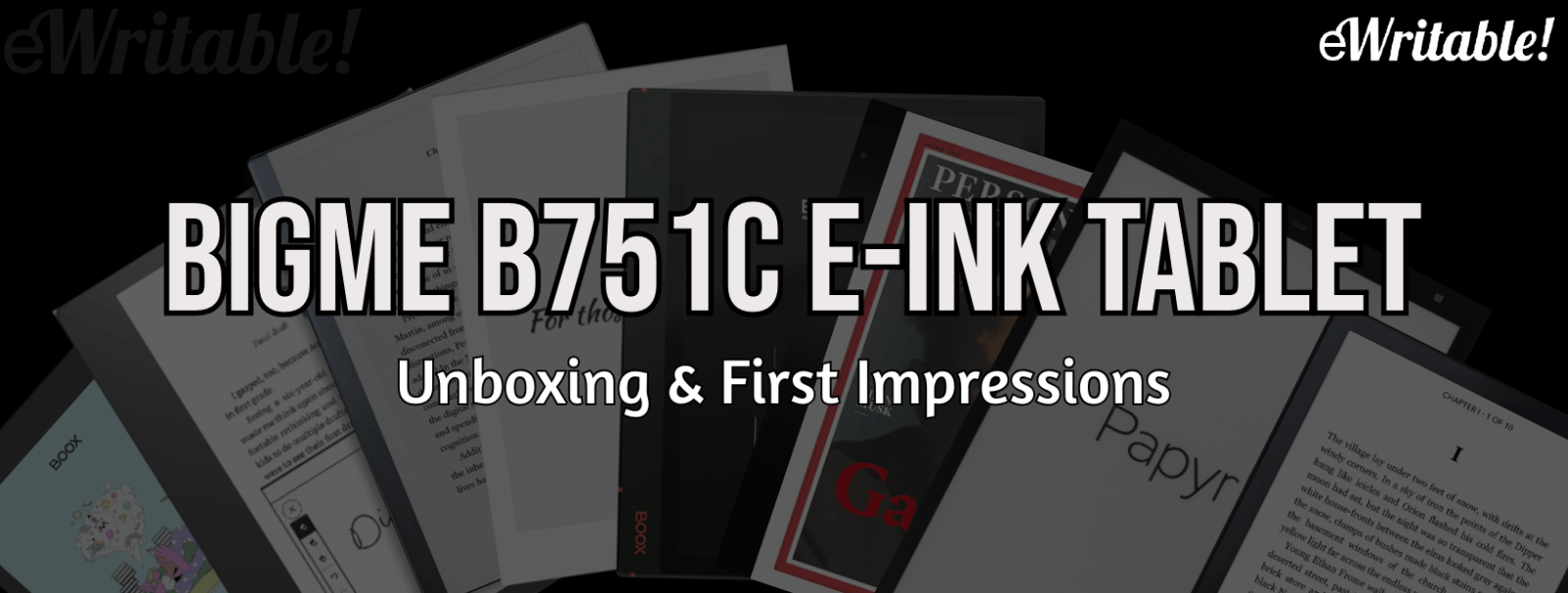Bigme sent me their new 7″ e-ink writing tablet, which I am looking forward to reviewing over the next week or so.
Whilst I make it no secret throughout this website that I much prefer to use larger-screened tablets, particularly for viewing PDFs, I must say that I am intrigued by this 7″ offering.
It is smaller than the usual “small” e-ink tablets, which have a screen size of 7.8″, so for me the B751C feels more like a highly-portable colour e-reader with note-taking facilities.
I should also add that this is the first Bigme e-ink tablet that I have directly reviewed myself (other Bigme reviews on eWritable, such as the Inknote Color+ were kindly provided by my friend Jeffrey Moss who has a lot more experience with Bigme than I do) so I am looking forward to seeing what the native software can do.
Transparency Notice: This unit was sent to me for free by Bigme for review purposes. The fact that I received it for free will not alter my thoughts and opinions about it and I’m not being paid to write favourably about it. However, it is important that I am transparent about the circumstances under which I obtained the tablet.
Unboxing
The package consisted of a beautifully designed box containing the tablet, the protective case, and a capacitive stylus (the B751C does not support Wacom styluses).

There is some disparity between the presentation of the tablet and that of the accessories. Whilst the tablet has a thoughtful, high-quality feel about it, the stylus and cover feel like they have just been thrown into the package at the last minute.
The Bigme B751C Tablet
The tablet is presented very nicely and feels rather premium, in a jet-black thick/hard cardboard box. Upon opening the box, there is a nice embossed message which reads “Just For You” – totally unnecessary, but a cute little touch.



The tablet is well-protected, inset within a foam inlay, with the USB-C cable (for charging and data transfer) above it. Underneath the tablet is a cardboard sleeve which contains the warranty and user guide. The User guide is in Chinese, so not much use to someone like me who is ignorant of any language that is not English.


The tablet’s screen is very small (7″ diagonal) compared to any other tablet on the market, but this means that it is possible to squeeze it into my jean’s pocket (which could be a selling point to some people). However, when it is inserted within the protective case and has the stylus attached, it no longer fits in my pocket.
The wider bezel on the left, which houses the page turn buttons makes the tablet’s shape feel more square than rectangular.
The rear panel is smooth plastic but does have some friction to prevent it from slipping out of the hand. There are also a series of indented lines that further enhance grip.
The power button is located on the left side of the top edge. On the left side of the bottom edge is a hole that I believe is for the microphone. And on the right side of the bottom edge is the MicroSD Card tray. On the left edge is the speaker (at the top) and the USB-C port (at the bottom). The right edge is plain.
The Stylus
In contrast to the glamorous presentation of the tablet, the stylus is a no-frills bog-standard capacitive pen. Taped to the stylus box was a smaller cardboard box that contained 2x spare nibs, a nib removal tool, and a tool for opening the MicroSD card tray.
As mentioned previously, the B751C screen does not have an integrated Wacom EMR layer, which means that Wacom-compatible styluses will not work with it. This also means that it requires a AAAA (quadruple-A) battery to provide power – that’s not an eraser on the top of the shaft, but a lid that you unscrew to replace the battery. Personally, I’m not a big fan of capacitive styli but I’ll reserve judgment until I’ve tested it out. On the shaft, toward the base of the stylus are two buttons – one for turning the stylus on, and a second that i believe is for erasing (and may be customisable for other functions, such as lasso-select).

The Protective Case
The protective case that ships with the Bigme B751C doesn’t feel entirely cheap but neither does it feel all that high quality.
The right side is a plastic tray that the tablet clips into. It holds the tablet fairly securely. The left side of the case also feels plasticky, but has been lined with faux leather on the exterior and has a softer lining on the interior. On the bottom right of the front of the case is the Bigme logo. There is also a pen loop for the stylus.


The two sides are joined with a patch of faux leather that occupies about three-fifths of the central region – this ensures that the speaker (at the top of the left edge) and the USB-C port (at the bottom of the left edge) are not blocked. There are also cut-outs on the plastic tray so that the power button and MicroSD card slot can be accessed whilst the tablet is within the case.


Initial Configuration
After booting up the Bigme B751C for the first time, I went through the initial setup stage.
This involved setting up the language, calibrating the stylus, setting up wifi (I still can’t get Android tablets to connect to my office wifi, so had to use my phone as a mobile hotspot), and choosing either the ‘office’ or ‘tablet’ theme.




First Impressions
First impressions were generally pretty good.
The screen looks nice, text appears clear, and the Kaleido 3 screen gives it a splash of colour (although be aware that there are limitations and even drawbacks to choosing colour over monochrome).
I liked the way that I can customize the vertical app toolbar (in the office theme) and had no problem installing GMail and Chrome web browser.
Although Bigme seems to have put a lot of effort into making their tablets suitable for the English-speaking market, particularly with the tutorials, there are several undertones of their Chinese roots. This is evident in the appearance of Chinese characters in several areas such as app names), as well as some alert messages that appear to be written in Chinglish. It was not really a massive issue but it was present.
Another point of note was that the Kindle app that was preinstalled must have been a version designed for the Chinese market. When I tried to logon to my Amazon account, it took me several failed attempts to realise that it was trying to logon to Amazon.cn. To resolve this issue, I uninstalled Kindle and reinstalled the latest version from the Google Play Store.
But, on the whole, my brief experience has been rather pleasant.
Over the next week (or so), I will be playing around with the Bigme B751C before writing up my final review and giving it a rating.
About the author
Dan Dutton is passionate about E-ink writing tablets, which bring together the pleasure of writing on paper with the power of digital technology. When he bought his first tablet, he realised that there wasn't a lot of unbiased information available for people that were considering buying an E-ink tablet, and so he built eWritable.








Good first impressions,
I could not see myself ever needing a mini E-ink tablet, unless, of course, it were a phone. That is something I would consider buying. But not one of those with changing “skin” outsides. They might look neat at the outset, but natural wear and tear would quickly destroy the initial novelty.
But I assume that the native ware is the same across bigme, so it will be interesting to see what your take on that front will be. A good hands on comparison with the main Onyx competitor and perhaps some fun speculation about the future direction of Bigme and its chances to compete with Boox.
Cheers,
I think it’s one of those devices that are for a specific use case. I think this use case would be for someone that wants a small and affordable portable colour tablet primarily for reading but with the option to write as well. Anyone that was considering the MobiScribe Wave Color now has another (perhaps better) option.
FYI, the bigme store and your specs page claims that the tablet has a fingerprint scanner. “The power button/fingerprint scanner is located on the left side of the top edge”.
I have not found a setting in the device to set up the fingerprint scanner and the power button does not visually look like a fingerprint scanner.
Could you take a look and see if you can figure this out? Thanks
Hey there,
Thank you for bringing this to my attention.
I think you are correct – there are no software settings for a fingerprint scanner and it just looks like a normal button.
This was an oversight on my part – I did not test this unit as thoroughly as I usually do due to other priorities and took for granted that the specs on Bigme’s website were accurate. Apologies for any inconvenience. I’ve updated the information on eWritable and will email Bigme to let them know of this inaccuracy.
Cheers,
Dan